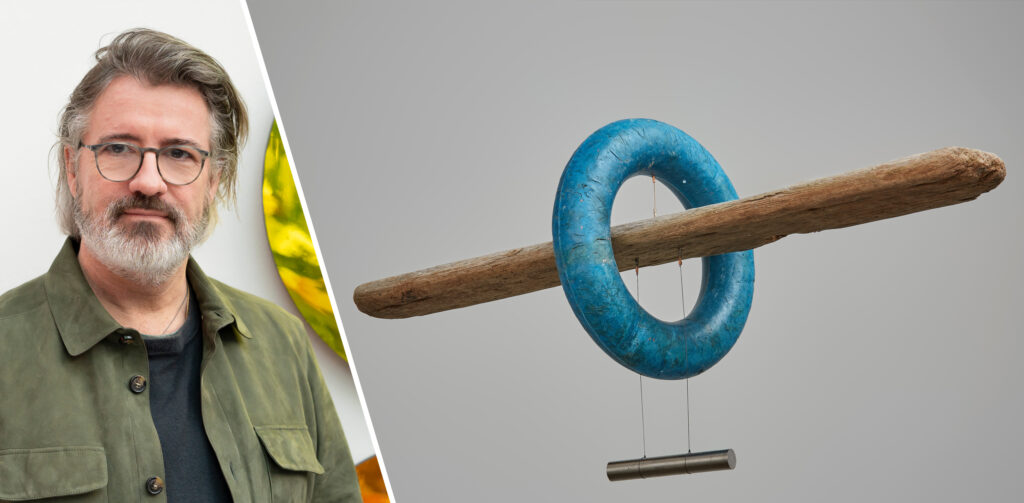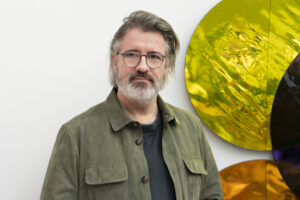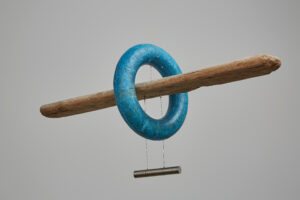‘Art can…expand our capacity for feeling empathy for others’: In conversation with Olafur Eliasson
“When I was growing up, I actually took the permanence of nature for granted.”

Olafur Eliasson, 'Shore compass (2:00, blue)', 2018; Installation view: i8 Gallery, Reykjavík; Photo: Vigfús Birgisson; Courtesy of the artist; i8 gallery, Reykjavik; © 2018 Olafur Eliasson
Olafur Eliasson’s work – featuring installations, paintings, sculptures, photography, and film – explores the relevance of art in the world at large. Born in 1967, Eliasson grew up in Iceland and Denmark and is now based in Berlin.
The weather project, an enormous artificial sun shrouded by mist, in the Turbine Hall of Tate Modern in London, marked the beginning of a new focus on the environment in Eliasson’s artistic practice.
How do we navigate a world of rising tides? Olafur Eliasson’s The Shore Compass – which features in A World of Water as part of the Sainsbury Centre’s Can the Seas Survive Us? season – visualises our search for direction in an uncertain world. Like a compass aligning with Earth’s magnetic field, it reminds us that North and South are always connected, shaping each other across shifting seas.
Bea Prutton, Digital Communications & Creative Curator at the Sainsbury Centre, was in conversation with Olafur Eliasson.
BP: How did growing up in Iceland shape your relationship to nature and your understanding of its fragility in the face of destructive human activity?
OE: When I was growing up, I actually took the permanence of nature for granted. Spending summers in Iceland with my grandparents, I felt a strong contrast between the environment there and the suburban environment in Denmark, where I lived most of the time. It was only later that I began to see how interwoven the natural and cultural worlds are. The landscape of Iceland has been deeply shaped by human activity, by deforestation and grazing, for example. It took me a long time to understand this and to see how these enormous glaciers in Iceland are not in fact eternal, but are under threat. In a way, it’s something we have to constantly remind ourselves of.
BP: Your piece, The weather project from 2003 marked the beginning of a new focus on the environment in your artistic practice. What do you feel your role or responsibility is as an artist working today?
OE: When I made The weather project in 2003, I was not yet thinking about the environment per se. The work grew out of my thinking about how our surroundings affect how we perceive something in general. In this case, how the weather affects your experience of a work of art or of a visit to a museum. That work of art, like everything I do, is intentionally open. Every artwork is completed by the way people interact with it, and make it into something new. This is physically manifested in The weather project in the large mirrors that clad the ceiling. I enjoyed watching how visitors engaged with their own reflections in the ceiling, many metres above them. Since then it has become common to associate the work with the environment, and reflects how my engagement with environmental questions in art grew out of an interest in context and how we are affected by and affect the world.

Portrait of Olafur Eliasson. Photo: Louise Yeowart, 2024
BP: Your piece, The Shore Compass in the Sainsbury Centre exhibition, A World of Water, aims to visualise our search for direction in an uncertain world. Could you please tell us a little bit about this work?
OE: The work on view is one of 24 compass artworks that I made using flotsam and jetsam, collected from the seaside in Iceland. These in turn are part of a larger body of works based on the principle of the compass. What interests me about compasses is that they connect to the planet in a way that is not dependent on individual human experience. The meaning of the compass, the orientation along the north–south axis and its importance for navigation, may be culturally defined, but the phenomenon itself is defined by the earth itself. I love this idea that no matter where you are on the planet, you know that all the other compasses are pointing along the same axis.
Anything can be made into a compass. So, I have explored using elements that I had lying around my studio. Here, I took things that my studio team and I found on the beaches, things that have this mysterious history, having travelled potentially from quite far away, across the ocean, and landed on the coast of Iceland.

Olafur Eliasson, ‘Shore compass (2:00, blue)’, 2018; Installation view: i8 Gallery, Reykjavík; Photo: Vigfús Birgisson; Courtesy of the artist; i8 gallery, Reykjavik; © 2018 Olafur Eliasson
BP: You consider the viewer to be often integral to a work, an active participant not only immersed in a piece of art but intrinsic to it. What power can that have with work centred around the climate crisis, in an exhibition season like Can the Seas Survive Us?
OE: Ideally, a work that deals with the climate crisis should be able to communicate something to the viewer that the normal methods of communicating cannot. It can be very challenging for scientists and climate activists to reach an audience, especially at a time like now, when the world seems ever more polarized. Art can touch people in a way that simply explaining something to them does not. I think it can make climate change tangible, and this opens up the potential for action.
BP: You once discussed “meeting up with art”, saying that art offers a unique, all-encompassing perspective on being human. At the Sainsbury Centre, we believe art is alive and has the agency and capacity to help us answer life’s biggest questions. How can meeting art as a living entity help us to understand the world around us?
OE: I believe it is important to have faith in the power of abstraction. In addition to showing us things that we may not yet know or telling us about the lives of others, art can in itself, in what it demands of us, expand our capacity for feeling empathy for others and for the more-than-human world.